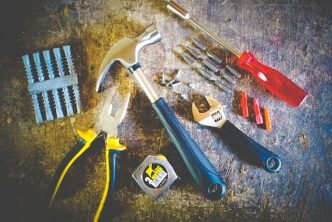Unexpected flat tires may make a typical drive on the road into a stressful experience. Having a trustworthy emergency solution is essential in these circumstances. Run-flat tires and spare tires are the two main choices. In order to assist you choose which is the best emergency solution for your vehicle, we will examine the advantages and disadvantages of each in this post.
Table of Contents
Understanding Run Flat Tires
Run flat tires, also known as self-supporting tires, are an amazing advancement in the realm of vehicle ease and safety. They are created specifically to let a vehicle to keep moving for a set amount of time after suffering a puncture or a considerable loss of tire pressure. Several important design elements and technological advancements enable this possibility.
Strengthened Sidewalls
The strengthened sidewalls are the backbone of run flat tire technology. Run flat tires, in contrast to ordinary tires, feature sidewalls that are thicker and more rigid due to the use of modern materials such reinforced rubber and specialized inner liners. Even when the tire is entirely deflated, the strengthened sidewalls are designed to carry the weight of the vehicle.
Advanced Rubber Compounds
When driving on a deflated tire, heat buildup can be prevented by the rubber compositions utilized in run flat tires. This heat resistance aids in halting the tire’s quick deterioration, guaranteeing that it will continue to offer sufficient support and performance when required.
(TPMS) Tire Pressure Monitoring Systems
Many contemporary automobiles are fitted with Tire Pressure Monitoring Systems (TPMS), which complement run flat tire technology. Each tire’s air pressure is continuously monitored by TPMS sensors, which notify the driver if there is a substantial loss of pressure. With the help of this early warning system, drivers may take the proper action before the tire’s performance is jeopardized, including slowing down or stopping at a service station.
Benefits of Run-Flat Tires
- No requirement for a Spare: One of the biggest benefits of run flat tires is that they do away with the requirement for a spare tire, which frees up space and lightens the load on your car. This may result in increased fuel economy.
- Safety: Run flat tires improve safety by enabling you to keep greater control of your car even after a tire puncture, lowering the likelihood of accidents brought on by unexpected blowouts.
- Convenience: You don’t have to stop on the side of the road to replace a flat tire or wait for roadside help right away when you have a run flat tire. You can keep going to a repair business or somewhere safer.
- Peace of Mind: Having run flat tires on your car might provide you some piece of mind, especially if you’re traveling a long distance or are in a location with few options for tire repair.
Run Flat Tires Drawbacks
- Higher Cost: Run flat tires are often more expensive than regular tires, and replacement costs might be high if they are irreparably damaged.
- Limited Range: Run flat tires only have a 50-mile maximum range following a puncture. If you’re located far from a service station or repair facility, this range might not be adequate.
- Ride Comfort: Compared to ordinary tires, some drivers find run-flat tires to offer a somewhat harsher ride. Personal taste may play a role here.
Having Spare Tires
Also referred to as “donut” or “doughnut” spare tires, spare tires are small, temporary tires used to transport a vehicle to the closest tire-repair shop in the event of a flat tire. They are frequently shorter and narrower than ordinary tires and are made for temporary use.
Advantages of Extra Tires
- Extended Range: The restricted range associated with run flat tires is not present with spare tires. If you follow the suggested speed limits, they can transport you to a repair shop no matter the distance.
- Cost-effectiveness: Spare tires are reasonably cheap, and if you get a flat tire, you might only need to repair the damaged tire and leave the spare in place.
- Smooth Ride: Compared to run-flat tires, many drivers believe that spare tires offer a smoother and more comfortable ride.
Drawbacks of Spare Tires
- Space and Weight: Spare tires take up space in the trunk and weigh down your car, which may affect how efficiently it uses fuel.
- Convenience: To install a spare tire, you must pull over to the side of the road, jack up your car, and swap out the flat tire. Particularly in bad weather, this operation can be time-consuming and inconvenient.
- Safety Concerns: Spare tires are less stable than run-flat tires, and driving on one for an extended period of time can be dangerous, especially at high speeds.
Making a Decision
Several elements, such as your driving habits, tastes, and the kind of vehicle you possess, will influence your decision regarding run flat tires vs. spare tires as your emergency remedy.
Think about run-flat tires if:
- You place a high value on safety and wish to reduce the possibility of accidents brought on by tire blowouts.
- You routinely travel long distances or through remote locations without many repair options.
- You need to be comfortable and feel calm.
Consider spare tires if:
- You place a high priority on cost efficiency and are prepared to give up some convenience for a smaller upfront cost.
- Although repairing a flat tire on the side of the road may be inconvenient, you prefer a smoother ride.
- You don’t have any serious reservations about the weight of the car or the trunk space.
Conclusion
There is no one-size-fits-all approach when deciding between run flat tires and extra tires as the ideal emergency alternative. Each solution has benefits and cons, and your particular needs and tastes will ultimately determine which is best for you.
Run flat tires provide security, comfort, and peace of mind but are more expensive and have a smaller operating radius. Conversely, spare tires are less expensive, offer a smoother ride, but necessitate stopping and changing the tire, which can be problematic.
Take into account aspects like your driving style, the terrain you usually drive on, and your willingness to invest in convenience and safety before making your choice. Ultimately, having a dependable emergency solution in your car is crucial for a worry-free driving experience, regardless of whether you choose run flat tires or spare tires.





